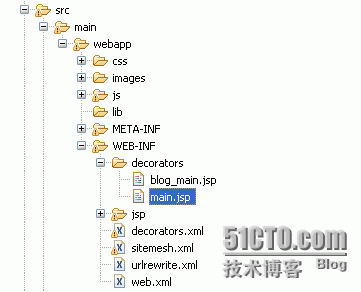sitemesh装饰器
来源:互联网 发布:淘宝钱夫人衣服好火啊 编辑:程序博客网 时间:2024/05/16 14:39
1
2
3
4
5
6
7
8
9
<!-- sitemesh config --> <filter> <filter-name>sitemesh</filter-name> <filter-class>com.opensymphony.module.sitemesh.filter.PageFilter </filter-class> </filter> <filter-mapping> <filter-name>sitemesh</filter-name> <url-pattern>/*</url-pattern> </filter-mapping>1
2
3
4
5
6
<!-- sitemesh --> <dependency> <groupId>opensymphony</groupId> <artifactId>sitemesh</artifactId> <version>2.4.2</version> </dependency>1
2
3
4
5
6
7
8
9
10
11
12
13
14
15
16
17
18
19
20
21
22
23
24
25
26
27
28
29
<!DOCTYPE HTML><%@ taglib uri="http://www.opensymphony.com/sitemesh/decorator" prefix="decorator"%><%@ page language="java" contentType="text/html; charset=utf-8" pageEncoding="utf-8"%><html lang="en"> <head> <link rel="icon" href="${contextPath}/images/favicon.ico" type="image/x-icon" /> <link rel="shortcut icon" href="${contextPath}/images/favicon.ico" type="image/x-icon" /> <meta http-equiv="Content-Type" content="text/html; charset=utf-8" /> <meta name="viewport" content="width=device-width, initial-scale=1.0"> <link rel="stylesheet" href="${cssRootPath}/common.css"> <jsp:include page="${jspRootPath}/includes/global/incScript.jsp"/> <!-- 从被装饰页面获取title标签内容,并设置默认值--> <title><decorator:title default="Blog - Shokay"/></title> <!-- 从被装饰页面获取head标签内容 --> <decorator:head/> </head> <body> <jsp:include page="${jspRootPath}/includes/common/incPageTopHideBar.jsp" /> <jsp:include page="${jspRootPath}/includes/common/incPageTopBar_blog.jsp" /> <div class="main-body"> <decorator:body /> </div> </body> <jsp:include page="${jspRootPath}/includes/common/incPageFooterBlog.jsp" /></html>1
2
3
4
5
6
7
8
9
10
11
12
13
14
15
16
17
18
19
20
21
22
23
24
25
26
27
28
<?xml version="1.0" encoding="ISO-8859-1"?><decorators defaultdir="/WEB-INF/decorators"> <!-- Any urls that are excluded will never be decorated by Sitemesh --> <excludes> <pattern>/changepassword*</pattern> <pattern>/*Ajax</pattern> <pattern>/*ajax</pattern> <pattern>/image</pattern> <pattern>/checkout/*</pattern> <pattern>/admin/search/*</pattern> <pattern>/index</pattern> </excludes> <!-- 方法一 设置需要访问的页面路径所对应的装饰器--> <decorator name="blog" page="blog_main.jsp"> <pattern>/blog/*</pattern> </decorator>
<!-- 方法二 设置装饰器,以后要在需要装饰的页面中增加<meta name="decorator" content="blog"-->
<decorator name="blog" page="blog_main.jsp"/>
<!-- main --> <decorator name="main" page="main.jsp"> <pattern>/*</pattern> </decorator> <decorator name="none"> <pattern>/index.jsp</pattern> </decorator></decorators>1
2
3
4
5
6
7
8
9
<sitemesh> <property name="decorators-file" value="/WEB-INF/decorators.xml"/> <excludes file="${decorators-file}"/> <page-parsers> <parser content-type="text/html" class="com.opensymphony.module.sitemesh.parser.HTMLPageParser" /> </page-parsers> <decorator-mappers>...</sitemesh>阅读全文
0 0
- SiteMesh装饰器
- sitemesh装饰器入门
- sitemesh装饰器
- sitemesh装饰器
- 【sitemesh】Jsp的装饰器组件sitemesh
- Springboot集成sitemesh装饰器
- siteMesh装饰器 指定装饰和不装饰
- 在struts2中加入装饰器sitemesh
- 【SSI开发总结.5】SiteMesh装饰器
- SiteMesh页面装饰器的使用步骤
- web SiteMesh(页面装饰器)
- sitemesh定义多个装饰器
- SiteMesh页面装饰器的使用步骤
- SiteMesh页面装饰器的使用步骤
- sitemesh定义多个装饰器
- SiteMesh--decorator(HTML装饰器)
- spring-boot集成sitemesh装饰器
- 关于sitemesh装饰器的使用方式
- javascript动态输出时间
- Fortran开发环境在Win7 64位下配置:Compaq Visual Fortran6.5 or 6.6
- 大数据正式11
- 即时通讯网
- 盘点 2017 年度最受欢迎的十大 Linux 服务器发行版
- sitemesh装饰器
- leetcode 231. Power of Two
- request(HttpServletRequest)对象 【get方法】
- 千兆网卡和普通网卡有什么区别?如何判断?
- win7下IIS的安装和配置 图文教程
- zoj2876Phone List题解
- 小玩具——温度采集项目(二)
- 如何扛住1.8亿/秒的双11数据洪峰?阿里流计算技术全揭秘
- JVM——Java虚拟机架构




